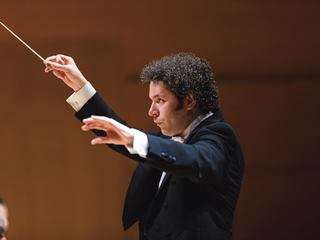|
Back
Bruckner from the West Coast New York
David Geffen Auditorium, Lincoln Center
11/24/2019 -
Anton Bruckner: Symphony No. 4 in E-flat major (“Romantic”)
Los Angeles Philharmonic, Gustavo Dudamel (conductor)

G. Dudamel (© Sam Comen)
Those of us living on the East Coast have relatively few occasions to hear the extremely popular Gustavo Dudamel conduct in the concert hall, as he is stationed in Los Angeles and does not guest conduct much on the other side of the country, so far as I can tell. This Sunday marked only the second time I have heard him, and in symphonic repertoire the first. Bruckner does not seem to be among his main calling-cards, and the Fourth in particular is a work that presents rather stringent and peculiar interpretive demands, for this Brucknerian at least, but Dudamel faced the challenges gamely. In fact, I was considerably more impressed here than I was at his highly anticipated Met debut in Otello about a year ago.
The Fourth Symphony has long been perhaps Bruckner’s single most popular work, and not without reason. No other Bruckner symphony gives me goosebumps quite so frequently. However, it is not as structurally unified as most of the composer’s later essays in the genre; the somewhat episodic finale in particular has been singled out for veering between the sublime and the banal, and arguably there is a bit of this in the first movement too. On the other hand, in some ways it finds Bruckner at his most atmospheric. One need not rely upon the composer’s own program for the work, which has medieval knights out for a hunt, to breathe the air of the forest, of nature in all its grandeur and terror, in this music—where Bruckner’s other symphonies (the Eighth and Ninth especially) tend to be more overtly dramatic, or even psychological, though I wince to use the word, in their impact. Its imperfections aside, the Fourth‘s splendors are manifold: consider the opening, with its horn calls set against shimmering strings; the scherzo, one of Bruckner’s most inspired, its trio section one of the most gently beguiling things he ever wrote; or the simple awe of the final coda.
The trick in the Fourth, then, is to bring out the sense of atmosphere, of mystery, of grandeur while hiding the compositional seams to reveal a masterpiece beneath them. Otherwise, the piece simply plods along between the big moments; at worst, these moments fall flat. In my mind I hear this work in Karajan’s two recordings; he solved its problems with his characteristic combination of patience, a strong grip on the long musical line, and careful attention to refinement of texture. Of course, in this last he had the enormous benefit of the Berlin Philharmonic—and even the best American orchestras tend to feature a leaner, drier sound, especially in the strings, than their Central European counterparts. Boston and Philadelphia have historically been exceptions to this rule, but the very fine Los Angeles Philharmonic, at least right now, is not. And of all the great Romantic composers, it is perhaps Bruckner whose music most demands a Central European sense of lushness and warmth.
Without that last ounce of orchestral richness to fall back upon, Dudamel’s sense for the musical argument and ability to inspire his players proved key. And in neither respect did he falter. One sign of mastery was his ability to set mostly quick tempos without ever seeming to rush. Extremely slow Bruckner is not necessarily ideal, but fast Bruckner can fall utterly flat if rhythmic poise is not perfectly maintained; is there any other composer whose music in performance should sound, as it were, slower than it really is? But of course there is more to conducting than control of tempo, and Dudamel consistently shaped phrases with a sure hand and an eye on the long line, minimizing the abruptness of not a few transitions and keeping a fine balance between anticipation and drama. Indeed, fortissimos were often absolutely explosive.
Yet this highly alert, intense approach had its drawbacks. The opening of the second-movement Andante, quasi allegretto—a surprising tempo indication for Bruckner, the great adagio composer—was forthright and assertive where it should have been hushed. And more distressing, and distracting, to me was the conductor’s fussing with dynamics during the grand brass chorale in the development section of the finale—the true climax of the work, I believe, and one of the most glorious, thrilling moments in all Bruckner. But these were no more than glitches, if striking ones, in a performance that was on the whole exceptionally cogent and palpably committed. I was reminded how magical this elusive symphony can be when all of its parts come together, and for that Dudamel and his orchestra have my heartfelt gratitude.
Samuel Wigutow
|